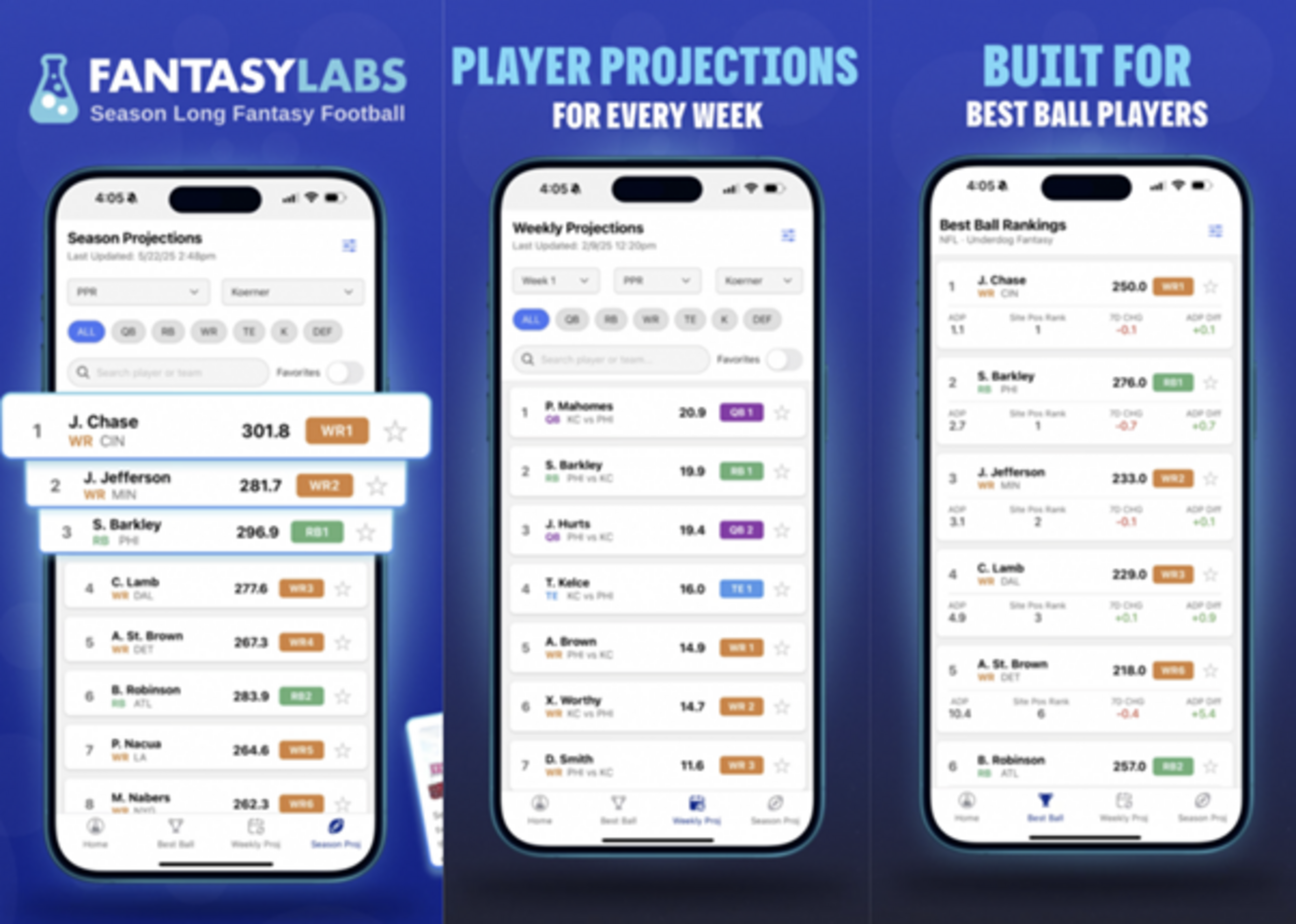
Stacking draft strategy explained: Fantasy Football stacks for 2025
Few strategies spark as much conversation in fantasy football drafts as “stacking.” This tactic centers on selecting multiple players from the same NFL team’s offense. When a quarterback throws a touchdown to his teammate, managers benefit from both points in their lineup. While stacking has been a favored method in daily fantasy contests for years, it’s now gaining traction in season-long and best ball formats too.
Below is an in-depth analysis, including players who fit an effective stacking strategy that you can target this season, whether it be re-draft leagues at Sleeper Fantasy or Underdog Best Ball drafts.
And don't forget to sign up for your fantasy football league on Yahoo Sports!
What is the Stacking Strategy?
Stacking in fantasy football drafts involves intentionally selecting several players from the same NFL team, often pairing a quarterback with one or more of his primary pass catchers—typically wide receivers or tight ends. This technique is designed to amplify your lineup’s upside by taking advantage of big games from those offenses. When a quarterback tosses a touchdown to his receiver, both members of your stack earn points together, resulting in a multiplying effect. Although stacking can make weekly scores more unpredictable, it’s an especially useful strategy in tournament-style or best ball leagues, where having a high ceiling is more valuable than steady, predictable points. The added layer of game theory allows managers to build unique lineups, gaining an edge when their chosen offense has an explosive outing.
Last season, fantasy managers who drafted Bengals duo Joe Burrow and Ja’Marr Chase enjoyed having two top-5 finishers on their teams. However, that path showed just how volatile stacking can be. Cincinnati’s offense struggled early in the campaign: Burrow ranked as a top-12 quarterback just four times in the first eight weeks, and Chase posted four weeks outside the top 30 among receivers by Week 9.
In the second half of the year, both players rebounded and their offense surged, leading to six combined finishes among the top two at their positions. Ideally, teams that invested in the Bengals stack managed enough early wins to fully benefit from their outstanding production in the fantasy playoffs.
Use promo code YARD20 for $20 off your FantasyLabs fantasy football subscription!

Pros of the Stacking Strategy
One of the major benefits of stacking in fantasy football is the way it boosts scoring potential. When you draft a quarterback alongside one of his main targets, every touchdown they connect on earns you points twice—once for the pass and once for the reception. This doubling effect can produce game-changing, high-scoring weeks that could tilt matchups in your favor. Stacking is especially effective in formats where having a high ceiling is critical, like best ball or large tournaments, giving managers a path to build unique lineups and capture the kind of top-tier output needed to outperform the competition.
Stacking also has the added advantage of making your draft strategy more straightforward by providing cohesion and correlation across your roster. Rather than assembling a mix of unrelated players, you’re intentionally backing an offense you expect to excel, which gives your lineup a clear direction. This streamlining not only helps simplify decisions on draft day, but it also sets you up to benefit from ideal game scenarios—such as fast-paced, high-scoring contests—where your stacked players can succeed together. By investing in a single offensive unit, you boost your chances of seeing several players hit big at once, rather than relying on random performances from different teams.
Dominate your Best Ball and season-long fantasy football leagues with FantasyLabs’ brand-new app that's available in the Apple App Store and on Android!

Cons of the Stacking Strategy
The main downside to stacking is the extra volatility it introduces to your lineup. Since your players’ production relies heavily on a single offense, an off week for that team can result in multiple starters disappointing at once. Factors like unfavorable game scripts, rough weather, or a challenging defensive matchup can derail your stack and leave you with a subpar score across several positions. This risk is especially noticeable in head-to-head season-long leagues, where steady output each week is often more valuable than the occasional scoring surge.
Another potential drawback is that stacking can cause you to reach for certain players or overlook better overall options during your draft. When you prioritize linking players—such as drafting a wide receiver or tight end just to pair with your quarterback—you might pass up on individuals who offer more upside on their own. This results in opportunity cost, as you sacrifice potentially higher-value talent for the sake of correlation. Plus, if the offense you’re banking on suffers a key injury or underperforms all year, your roster could end up with a major weakness that’s difficult to address as the season goes on.
Best Ball rankings from some of the top industry experts are also available on FantasyLabs.

Top Stacking Targets in 2025
Dak Prescott, QB, and CeeDee Lamb, WR, Dallas Cowboys
Another offseason filled with turmoil in Dallas appears to have lowered expectations for the team as a whole. Dak Prescott missed most of the 2024 season with a hamstring injury, but just two years earlier, he finished third among quarterbacks in fantasy points. Notably, Prescott has delivered a top-7 fantasy season at his position in every odd year since 2019—and here we are in 2025.
Last season, CeeDee Lamb led all receivers in fantasy scoring, racking up 135 receptions for 1,749 yards and 12 touchdowns. The Cowboys’ defense remains a work in progress, especially with ongoing questions about Micah Parsons, and the team chose not to use any draft picks on a high-upside running back. It’s reasonable to expect another pass-heavy approach in Dallas this year.
Lamb is the third wide receiver in Sean Koerner's rankings and Prescott is down at QB11. Owners that grab Lamb in the first round should strongly consider picking up his signal caller later in the draft.
Check out our expert fantasy football rankings to see what other stacks may be possible during your drafts.
JJ McCarthy, QB, and Justin Jefferson, WR, Minnesota Vikings
JJ McCarthy remains a total wild card in fantasy football, but that unpredictability actually adds draft value. Stacking is all about betting on high-powered offenses, and Kevin O’Connell’s system in Minnesota has consistently produced no matter who’s played quarterback—McCarthy might be the most skilled signal-caller the team has had since O’Connell took over.
Last year, Sam Darnold delivered a top-10 fantasy campaign, while Justin Jefferson finished second at receiver—trailing only Ja’Marr Chase, his former college teammate—even though it was considered a “down” season for Jefferson. The Vikings are poised to improve their offensive line and running game this year, which could mean some shift toward controlling the clock. Still, the weekly plan will feature plenty of play-action deep shots to Jefferson.
Koerner ranks Jefferson as WR2 going into the season, and McCarthy comes in at a bargain as QB17.
Check out Sean Koerner's WR Tiers article to see how he stacks up all the wide receivers this draft season.
Baker Mayfield, QB, Mike Evans, WR, and Emeka Egbuka, WR, Tampa Bay Buccaneers
Stacking isn’t limited to connecting a quarterback with one receiver—it can extend to rostering multiple pass-catchers from the same team, and Tampa Bay may be the most appealing option for managers looking to snag several pieces of a potent offense in the mid-rounds. Baker Mayfield has revitalized his career with the Buccaneers, quietly finishing last season fourth among fantasy quarterbacks with 4,500 passing yards and 41 touchdowns.
Mike Evans continued his impressive streak by exceeding 1,000 receiving yards once again to close out 2024, and he clearly still has plenty left to offer, especially as a red-zone threat. Evans recorded three top-5 fantasy performances over the final six games of last season and scored 11 touchdowns in just 14 contests.
Evans is joined by first-round draft pick Emeka Egbuka from Ohio State, who may be the most complete receiver of the 2025 draft. With the continuous injury concerns of Chris Godwin, Egbuka should be on the field a lot for the Buccaneers and Mayfield is not shy about taking shots.
The consensus projections have Mayfield at QB7 with Evans and Egbuka at WR18 and WR33. Those feel like strong values to stack in the mid rounds after grabbing some high-end playmakers early in the draft.
More must-reads:
- 25 NFL players who are playing for their next contract in 2025
- 5 Players That You Need to Avoid in Fantasy Football
- The 'Active 3-passing-TD game leaders' quiz
Breaking News
Trending News
Customize Your Newsletter
 +
+
Get the latest news and rumors, customized to your favorite sports and teams. Emailed daily. Always free!








